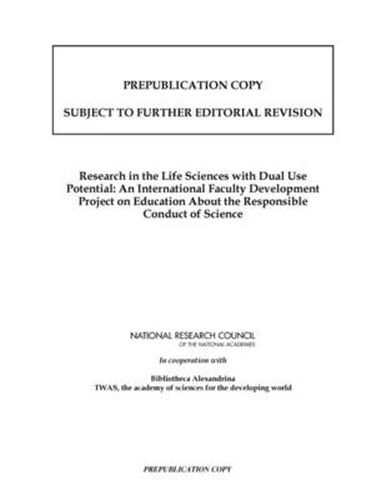Readings Newsletter
Become a Readings Member to make your shopping experience even easier.
Sign in or sign up for free!
You’re not far away from qualifying for FREE standard shipping within Australia
You’ve qualified for FREE standard shipping within Australia
The cart is loading…






In many countries, colleges and universities are where the majority of innovative research is done; in all cases, they are where future scientists receive both their initial training and their initial introduction to the norms of scientific conduct regardless of their eventual career paths. Thus, institutions of higher education are particularly relevant to the tasks of education on research with dual use potential, whether for faculty, postdoctoral researchers, graduate and undergraduate students, or technical staff. Research in the Life Sciences with Dual Use Potential describes the outcomes of the planning meeting for a two-year project to develop a network of faculty who will be able to teach the challenges of research in the life sciences with dual use potential. Faculty will be able to incorporate such concepts into their teaching and research through exposure to the tenets of responsible conduct of research in active learning teaching methods. This report is intended to provide guidelines for that effort and to be applicable to any country wishing to adopt this educational model that combines principles of active learning and training with attention to norms of responsible science. The potential audiences include a broad array of current and future scientists and the policymakers who develop laws and regulations around issues of dual use.
$9.00 standard shipping within Australia
FREE standard shipping within Australia for orders over $100.00
Express & International shipping calculated at checkout
In many countries, colleges and universities are where the majority of innovative research is done; in all cases, they are where future scientists receive both their initial training and their initial introduction to the norms of scientific conduct regardless of their eventual career paths. Thus, institutions of higher education are particularly relevant to the tasks of education on research with dual use potential, whether for faculty, postdoctoral researchers, graduate and undergraduate students, or technical staff. Research in the Life Sciences with Dual Use Potential describes the outcomes of the planning meeting for a two-year project to develop a network of faculty who will be able to teach the challenges of research in the life sciences with dual use potential. Faculty will be able to incorporate such concepts into their teaching and research through exposure to the tenets of responsible conduct of research in active learning teaching methods. This report is intended to provide guidelines for that effort and to be applicable to any country wishing to adopt this educational model that combines principles of active learning and training with attention to norms of responsible science. The potential audiences include a broad array of current and future scientists and the policymakers who develop laws and regulations around issues of dual use.